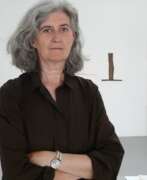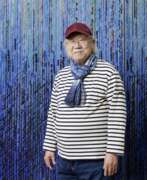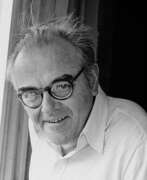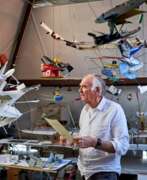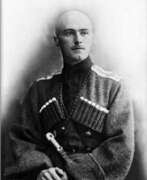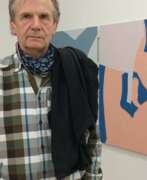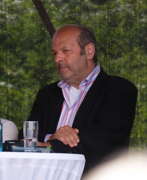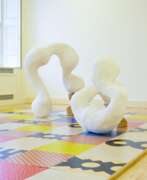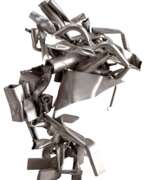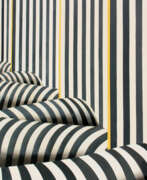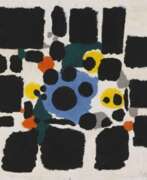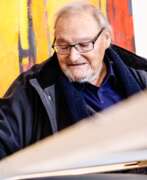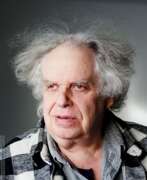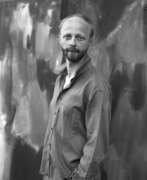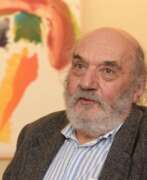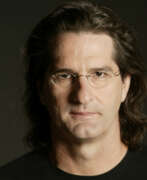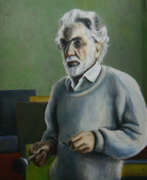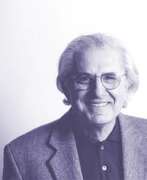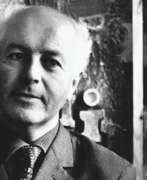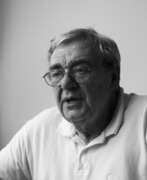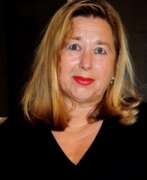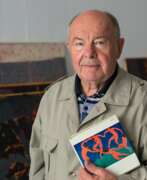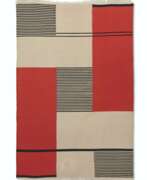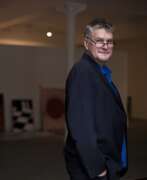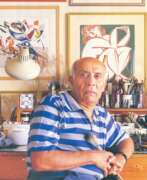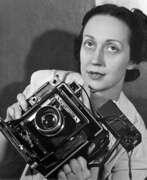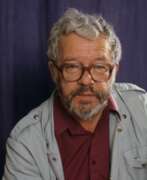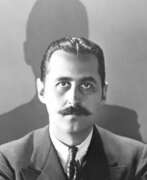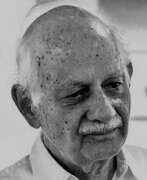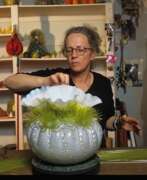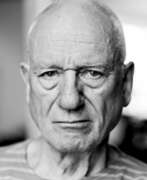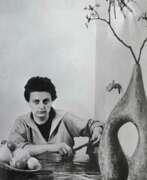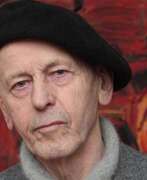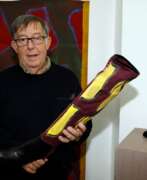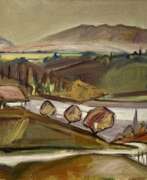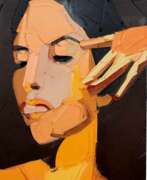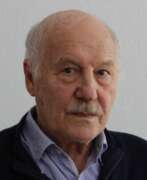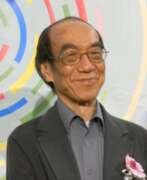Educators Abstract art
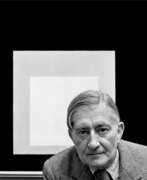

Josef Albers was a German-born artist and educator. The first living artist to be given a solo shows at MoMA and at the Metropolitan Museum of Art in New York, he taught at the Bauhaus and Black Mountain College, headed Yale University's department of design, and is considered one of the most influential teachers of the visual arts in the twentieth century.
As an artist, Albers worked in several disciplines, including photography, typography, murals and printmaking. He is best known for his work as an abstract painter and a theorist. His book Interaction of Color was published in 1963.
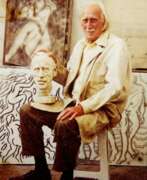

Harold Ambellan is an American painter and sculptor.
He studied sculpture and fine art in Buffalo before moving to New York City. The human figure is central to Harold Ambellan's work. He created monumental figures and drew extensively, leaving thousands of drawings. Ambellan was one of the participants in Roosevelt's Federal Art Project, which hired hundreds of artists during the Great Depression who collectively created more than 100,000 paintings and over 18,000 sculptures.
Ambellan remained committed to figuration in both his sculpture and painting. He was elected president of the Sculptors Guild of America in 1941, and that same year his work was exhibited in group shows at the Metropolitan Museum of Art in New York and the Academy of Fine Arts in Philadelphia.
In 1944, Ambellan participated in the liberation of Normandy as part of the U.S. Navy, then taught three-dimensional art at the Workshop School in New York City. In 1954, for political reasons, Ambellan moved to France and remained there for the rest of his life, working and exhibiting throughout Europe.
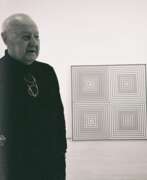

Richard Joseph Anuszkiewicz was a prominent American artist celebrated for his foundational contributions to the Op Art movement. Born in Erie, Pennsylvania, to Polish immigrant parents, Anuszkiewicz's early talent in art earned him scholarships, leading to his studies at the Cleveland Institute of Art and later, the Yale University School of Art and Architecture under Josef Albers. Albers, a pivotal figure in his career, inspired Anuszkiewicz to explore the intricacies of color and geometric forms, steering him away from realism towards a more abstract and mathematical approach to art.
Anuszkiewicz gained prominence in the 1960s, notably through his participation in the landmark exhibition "The Responsive Eye" at MoMA, which played a crucial role in propelling Op Art into mainstream recognition. His works, characterized by vibrant colors and geometric patterns, create illusions of depth and movement, challenging viewers' perceptions and offering a mesmerizing visual experience. His technique was not just about the visual impact; it was a meticulous, mathematical exploration of color and form, aiming to achieve a 'very, very mechanistic geometry' that was nonetheless romantic in its precision and purity.
Throughout his career, Anuszkiewicz's art evolved, yet he remained faithful to his intellectual and analytical approach, focusing on the optical effects of color and shape. His contributions extended beyond painting to include printmaking and sculpture, showcasing his versatility as an artist. Notably, his works are housed in prestigious collections around the world, including the Metropolitan Museum of Art, Museum of Modern Art, and the Whitney Museum of American Art, among others.
For collectors and experts in art and antiques, Anuszkiewicz's work embodies the confluence of scientific precision and artistic expression, offering insights into the profound impact of color and form on human perception. His legacy continues to inspire and challenge the boundaries of visual art.
If you're captivated by the transformative power of Op Art and the pioneering work of Richard Joseph Anuszkiewicz, sign up for updates. Stay informed about new product sales and auction events related to this remarkable artist's oeuvre, enriching your collection with pieces that resonate with history and innovation.
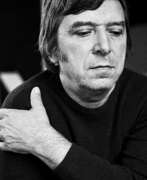

Hermann Bachmann is a German artist, graphic designer and teacher.
Hermann studied at the School of Applied Arts Offenbach am Main and served in the army during World War II. In 1945, Bachmann returned to his hometown and joined the artists of the Halle School. And in 1953 he fled to West Berlin, whose creative atmosphere was closer to him.
In 1957 Hermann Bachmann became a teacher and later a professor at the University of Fine Arts in Berlin, among his students many famous artists. He was a member of the Association of German Artists.
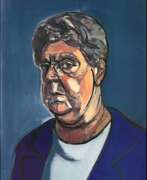

Leland Bell, an American painter born in 1922 and passed away in 1991, is a figure whose artistic journey and output stand as a beacon of individuality and depth in the 20th-century art world. Bell's dedication to painting was profound, shaping a career that remained largely self-taught yet significantly influential. His work, characterized by a passionate engagement with both abstract and figurative painting, represents a unique blend that defied the dominant trends of his time, making him a crucial figure for collectors and art enthusiasts.
Bell's artistic signature is evident in his choice of subjects—still life, portraiture, and figure composition—handled with a distinctive blend of abstract principles and figurative clarity. His paintings are recognized for their bold contour lines, vibrant planes of color, and dynamic compositions, revealing a singular vision that bridges the abstract with the tangible. This approach allowed him to explore the depth of human and thematic elements with an intensity and psychological complexity, particularly seen in his self-portraits and family group scenes, which often carry a mythic quality, elevating everyday existence to the level of allegory.
Significant in Bell’s legacy is his ability to convey the essence of his subjects with a sculptural weight, granting them a presence that is both immediate and timeless. His paintings, such as the "Family Group with Butterfly" (1986-90) and his series of self-portraits, demonstrate a mastery of form and space that invites viewers into a deeply personal yet universally resonant world. Bell's influence extended beyond his canvas through his roles as a teacher and lecturer, where he passionately advocated for the artists he revered, contributing to a rich educational legacy that complemented his artistic achievements.
Bell's works are held in prestigious collections and have been the subject of retrospective exhibitions, such as at the Phillips Collection in Washington, DC, highlighting his enduring impact on American art. His dedication to exploring the nuances of form, color, and composition has left a lasting mark, ensuring his place among the notable artists of his generation.
For collectors and experts in the field of art and antiques, Leland Bell's oeuvre offers a compelling study in the power of painting to convey complex human emotions and narratives. His work remains a testament to the enduring relevance of figurative art in the modern era, and his contributions continue to inspire new generations of artists and collectors alike.
To stay informed about new discoveries, sales, and auction events related to Leland Bell's work, signing up for updates is a practical way to ensure you don't miss out on opportunities to engage with the legacy of this remarkable artist. This subscription is a business-like avenue to keep abreast of events that celebrate Bell’s artistic achievements and offer insights into his profound impact on the art world.
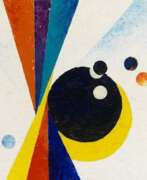

Joseph Binder, full name Joseph Friedrich Gustav Binder, was a German avant-garde painter, designer and graphic artist.
In the early 1930s, Joseph Binder worked on major brand commissions for Knorr, Reemtsma, Tekrum, Elida, Minera, Dujardin, Stella and Mercedes-Benz and earned fame as a style-defining industrial designer. In all, by the early 1960s, Binder had created more than 2,000 stamps and posters.
In painting, Binder favored cubism: geometrically stylized form is of great importance to the painter. He was also influenced by the Bauhaus school of art and the Blue Rider group.


Andreas Böhm is a German painter, graphic artist and art teacher at Brunsbüttel Upper Secondary School from 1980. He lives and works in Dingen, Schleswig-Holstein.
For a long time Andreas Bem was known for his stencil drawings, which are like silhouettes with just two or three thick layers of paint. As an artist, he continued to play with shapes, but now adapted the free lines of wildlife.
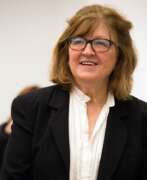

Vija Celmins is a Latvian-American artist. She is best known for her photorealistic paintings and drawings of natural and man-made objects.
Celmins and her family fled Latvia during World War II and eventually settled in the United States. She studied art at the John Herron School of Art in Indianapolis and later at the University of California, Los Angeles.
Celmins began her career as a painter in the 1960s, and by the 1970s she had developed her signature style of photorealism. She is known for her painstaking attention to detail, and her paintings and drawings often take months or even years to complete. Some of her most famous works include images of the night sky, oceans, and rocks.
Celmins has been the subject of numerous solo exhibitions in museums and galleries around the world, including a retrospective at the Centre Pompidou in Paris in 2006. Her work is held in the collections of many major museums, including the Metropolitan Museum of Art in New York, the Museum of Modern Art in New York, and the National Gallery of Art in Washington, D.C.


Fernando de Szyszlo Valdelomar was a Peruvian painter, sculptor, printmaker, and teacher who was a key figure in advancing abstract art in Latin America since the mid-1950s, and one of the leading plastic artists in Peru.


Gerhard Fietz was a German painter, professor and representative of non-objective painting. He is considered an important painter of the second half of the 20th century in Germany.
As a co-founder of the artist group ZEN 49, he opposed traditional representational art and, together with painters such as Willi Baumeister, Fritz Winter and Rupprecht Geiger, developed a style of painting that focused on experimenting with artistic means. Fietz exhibited at numerous national and international exhibitions, including the highly regarded exhibition at the Cercle Volnay in Paris in 1955.
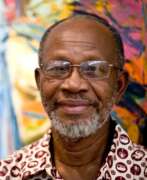

Ablade Glover is a Ghanaian artist and educator. He has exhibited widely, building an international reputation over several decades, as well as being regarded as a seminal figure on the West African art scene. His work is held in many prestigious private and public collections, which include the Imperial Palace of Japan, the UNESCO headquarters in Paris and Chicago's O'Hare International Airport. He has received several national and international awards, including the Order of the Volta in Ghana, and is a Life Fellow of the Royal Society of Arts, London. He was Associate Professor, Head of the Department of Art Education and Dean of the College of Art at the Kwame Nkrumah University of Science and Technology until 1994.
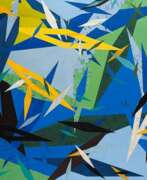

Dieter Haack is a German abstractionist painter.
Dieter Haack studied painting at the Düsseldorf Academy of Fine Arts. His works are characterised by bold colours and energetic compositions.
In addition to his art practice, Haack also worked as a professor of painting and drawing at his alma mater.
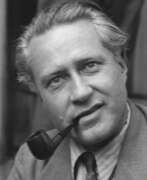

Hans Jaenisch is a German abstractionist painter, graphic artist and university lecturer.
Hans Jaenisch's artistic legacy is kept in the Fritz-Winter-Haus archive, Alain, Westphalia, and is presented to the public in regular exhibitions.
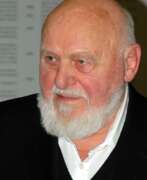

Jan Koblasa was a Czech sculptor, painter, graphic artist, author of philosophical essays and university lecturer. He studied at the Prague Academy of Fine Arts.
Jan Koblasa was a professor of sculpture at the Mufeus Art Academy in Kiel from 1969 to 1997. His lessons included traditional plastic forms of expression, such as portraits, figures and nudes, but he also gave his students great freedom for further artistic activity.
From 2002 to 2005, Koblasa taught as professor emeritus of sculpture at the Academy of Fine Arts in Prague.


Martin Krampen was a leading German semiotician, semiotics Professor in Göttingen.
Over the course of his career Krampen held position at universities across North America and Europe teaching courses in social psychology, semiotics, and the psychology of design.
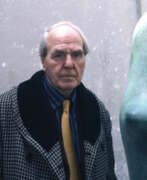

Henry Spencer Moore was an influential English sculptor and artist, renowned for his semi-abstract monumental bronze sculptures that have found homes around the world as public works of art. Born on July 30, 1898, in Castleford, Yorkshire, Moore showed early talent in art, but his journey towards becoming a sculptor was not straightforward. His experiences as a young teacher and a soldier in the First World War, where he was injured in a gas attack, significantly shaped his perspectives and artistic direction.
After the war, Moore pursued his passion for art, winning a scholarship to the Royal College of Art in London, where he began to experiment with modernist influences and direct carving techniques, moving away from the traditional Victorian style. His works, characterized by organic shapes and a blend of abstraction and figuration, were inspired by a wide range of sources, including primitive art, the human body, and the natural world.
Moore's sculptures are celebrated for their unique ability to blend form with space in the landscape, offering viewers a dynamic interaction with his works. His dedication to public art made his sculptures accessible to a wide audience, contributing to his status as one of the 20th century's most significant sculptors. Moore's legacy is preserved through the Henry Moore Foundation, which supports artists and promotes public appreciation of sculpture.
For collectors and experts in art and antiques, Moore's work remains a testament to the power of sculpture to evoke emotion and thought. His contributions to modern art and sculpture continue to inspire and influence artists around the world.
To stay informed about new exhibitions and opportunities to view Henry Spencer Moore's work, sign up for updates. This subscription will ensure you are alerted to new product sales and auction events related to Moore's influential body of work.


Bernhard Müller-Feyen was a German painter, sculptor and teacher.
He was a master student at the Werkschulen in Cologne, a teacher at the art academy in Istanbul, and a freelance painter in his hometown of Adenau. Müller-Feyen's pictorial works were mainly abstract landscapes, while in sculpture he created minimalist forms. In 1985 his first anthropomorphic looping forms, also called archetypes, emerged. And his last work before his death was a memorial to the victims of September 11, 2001 at Ground Zero in New York City.
Müller-Feyen's work has been featured in many national and international exhibitions.
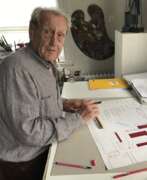

Waldemar Nottbohm is a German painter, sculptor and teacher. He studied art in Hamburg, Hanover and Lüneburg. In 1957 he received a sculptor's degree in stonemasonry and metal design.
Waldemar Nottbohm is known for his abstract geometric sculptures in different materials.


Wolfgang Opitz is a contemporary German artist known for his abstract paintings.
Wolfgang Opitz studied art from 1964 to 1968 in Erfurt and Dresden. He met A. R. Penck, with whom he made many experimental films in 1969. They also founded the group Lücke in 1971, together with artists Harald Gallasch and Steffen Koonert (Turk). In 1989, Opitz fled East Germany to the West, where he received a teaching position at Lüneburg University in 1991.
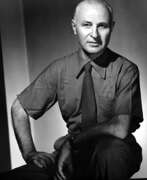

Emilio Pettoruti was an Argentine painter, heralded as a pioneer of abstract art in South America. Born in La Plata, Argentina, in 1892, Pettoruti was self-taught, drawing inspiration from his surroundings and experiences from an early age. His artistic journey took him to Italy in 1913 on a government scholarship, where he immersed himself in the avant-garde movements of Europe, notably Futurism, and interacted with key figures of the time such as Pablo Picasso and Juan Gris. This European sojourn significantly influenced his artistic direction, introducing him to synthetic cubism, futurism, and the early Renaissance painting, which he would later blend into his unique style.
Pettoruti's work, especially post his return to Buenos Aires, scandalized and fascinated the Argentine public in equal measure. His avant-garde cubist exhibition in 1924 marked a pivotal moment in Argentine art, challenging traditional concepts and inviting viewers into a dialogue with the new and modern. He frequently depicted musicians and harlequins, using these figures to explore themes of anonymity, cultural identity, and the essence of human expression. Through his abstract compositions, Pettoruti conveyed a sense of rhythm and movement, often incorporating elements of light as a tangible presence within his works. Notably, his Copa series and later abstract works exemplify his mastery of form, color, and light, showcasing a progression towards complete abstraction.
Among Pettoruti's significant works are "El Sifón" (1915), "La Grotta Azzurra di Capri" (1918), and "Quinteto" (1927), with many held in prestigious collections, including the Museo Nacional de Bellas Artes in Buenos Aires. His artistic legacy is a testament to his role as a critical figure in introducing and establishing avant-garde art in Latin America.
For those intrigued by Emilio Pettoruti's groundbreaking work and wish to explore more about his contributions to modern art, signing up for updates can provide exclusive insights into upcoming sales and auction events dedicated to his art. This subscription offers a unique opportunity for collectors and experts in art and antiques to stay informed about the vibrant legacy of Pettoruti's work.


Caesar W. Radetzky-Radetz is a German painter and author. In addition to his work as a freelance artist, he worked as an art teacher with children and young people and as a lecturer in painting at the Reichenhall Art Academy. His works are known and valued through lively international exhibitions and are represented in numerous public and private collections. Radetzky works with oil, watercolor or mixed media, with large image formats being preferred.
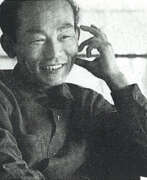

Yoshishige Saitō was a Japanese visual artist and art educator.
Saitō was a seminal figure in Japanese art of the 20th century and a crucial link between the prewar avant-garde and postwar abstract art in Japan. From early on, he was exposed to Post-Impressionism and the avant-garde movements, including Russian constructivism and European Dada, as well as Western literature and Marxism. In the 1930s, he became active in the avant-garde art circles, while pursuing abstraction in paintings and wood reliefs, most notably the relief series of Kara kara and Toro Wood. All of his prewar works and related materials were lost to an air-raid fire in 1945, some of them were reconstructed in the 1970s.
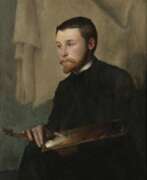

Paul Sérusier was a French Post-Impressionist painter and theorist, notable for his significant contributions to the art movement known as the Nabis. Born in Paris on November 9, 1864, Sérusier's work is characterized by its expressive use of color and pattern, inspired by the techniques of Paul Gauguin. He is best known for his exploration of color, sensation, and abstraction, particularly evident in works like "Le Talisman, the Aven River at the Bois d'Amour" (1888). This painting marks a departure from the Impressionists' more faithful representation of observed reality, focusing instead on translating sensations onto the canvas with vibrant brushstrokes and an emphasis on emotional expression over visual accuracy.
Sérusier's paintings often feature the landscapes and people of Brittany, notable for their contemplative mood achieved through firm contours and blocks of unmodulated color. His style evolved under the influence of Synthetism and Cloisonnism, favoring flattened forms and large swathes of color, as seen in "Farmhouse at le Pouldu" (1890). This approach reflects a decorative organization of objects, emphasizing the craft and execution of the scene.
Some of Sérusier's notable works are housed in prestigious museums such as the Musée d'Orsay in Paris, including "Portrait of Paul Ranson in Nabi Costume" (1890) and "Landscape" (1912). His legacy extends beyond his own artworks; he was a key figure in the formation of the Nabis movement, and his theoretical contributions have had a lasting impact on the art world.
For collectors and experts in art and antiques, Sérusier's work represents a unique blend of post-impressionist and symbolist styles, making his pieces highly valued both for their historical significance and their aesthetic appeal. To stay updated on new product sales and auction events related to Paul Sérusier, sign up for our updates. This subscription service is exclusively focused on providing information related to Sérusier's work, ensuring you remain informed about opportunities to acquire pieces by this influential artist.
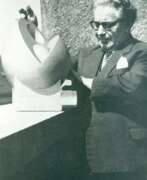

Victor Servranckx was a Belgian artist renowned for his pioneering contributions to abstract painting and design. Born in Diegem in 1897, Servranckx's artistic journey commenced at the Brussels Royal Academy of Fine Arts, where his studies spanned from 1913 to 1917. It was here he forged a significant connection with René Magritte, leading to their collaborative work "Pure Art: A Defence of the Aesthetic" in 1922.
Victor Servranckx's art is distinguished by its embrace of cubism, constructivism, and surrealism, showcasing a dynamic interplay of geometric forms and innovative design principles. His artistic endeavors were not confined to painting alone; he delved into abstract sculpture and collage, contributing significantly to various art magazines and influencing future generations of artists.
Noteworthy is Victor Servranckx's international recognition, evidenced by his participation in exhibitions across Europe and the United States. His works were exhibited alongside notable figures like Marcel Duchamp and Fernand Léger, highlighting his importance in the art world. Despite a mixed reception in Belgium, his influence endured, culminating in a retrospective at the Musée d'Ixelles shortly before his death in 1965.
For collectors and experts in art and antiques, Servranckx's oeuvre represents a vital chapter in the history of abstract art, offering a window into the evolving artistic trends of the early 20th century. His works, such as "Opus 17-1922" and "Opus 30-1922 (Factory)," are emblematic of his innovative approach and are held in high regard in collections worldwide, including the Museo Nacional Thyssen-Bornemisza.
If Victor Servranckx's artistic vision resonates with you, consider staying updated on exhibitions and auction events featuring his works. Subscribing to updates will ensure you're informed about new opportunities to explore and acquire pieces by this influential artist.
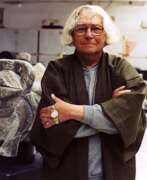

Pierre Szekely was a Hungarian sculptor, architect and educator. In the 1940s, after surviving the holocaust, Szekely became a resident of France, and eventually became an avante garde architect and international lecturer of art philosophy.
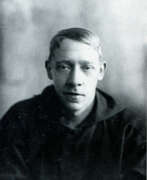

Vladimir Evgrafovich Tatlin (Russian: Владимир Евграфович Татлин) was a pioneering Russian and Soviet avant-garde artist, architect, and designer, celebrated for his innovative contributions to modern art, sculpture, and architecture. Born in Moscow, Tatlin's work transcended traditional boundaries, blending art with technology and ideology in a way that was revolutionary for his time. His dedication to merging functional design with artistic vision marked him as a key figure in the Constructivist movement, which sought to apply art to practical and social purposes.
Tatlin is best known for his ambitious but never-realized project, the Monument to the Third International, commonly referred to as Tatlin's Tower. This monumental structure, intended to serve as the headquarters for the Comintern in Petrograd, symbolized the utopian aspirations of the Soviet Union in the early 1920s. The tower's design, featuring a spiraling iron frame reaching 400 meters in height, embodied the avant-garde's commitment to innovation and the belief in art's power to shape a new societal order. Though it remained unbuilt, the tower's visionary design continues to influence architects and artists worldwide.
Beyond Tatlin's Tower, his contributions to the world of art include significant works in painting and sculpture. His approach to material and form, particularly his counter-reliefs, challenged traditional artistic conventions and opened new avenues for exploration in modern art. Tatlin's legacy extends to educational realms as well, where his tenure at the Moscow Vkhutemas (the Higher Art and Technical Studios) helped shape a generation of artists and designers. His works are preserved in major museums and galleries around the globe, serving as a testament to his enduring influence on culture and art.
For collectors and experts in art and antiques, Vladimir Tatlin's oeuvre represents a pivotal moment in the evolution of modernist expression. His innovative spirit and radical designs continue to inspire and provoke. If you wish to stay informed about new discoveries, sales, and auction events related to Vladimir Evgrafovich Tatlin, we invite you to sign up for our updates. This subscription is an excellent opportunity for enthusiasts and collectors to stay ahead in the dynamic world of art and antiques.


Alma Woodsey Thomas was a twentieth-century American artist. She is known as a painter and educator, a member of the Harlem Renaissance African American cultural movement.
Alma Thomas rose to fame as an artist after her retirement after a 35-year career teaching high school art in Washington, DC. She created colorful abstract paintings. The artist's technique was to draw thin pencil lines on canvas to create shapes and patterns and then fill the canvas with paint. Thomas' later work has been compared by critics to West African paintings and Byzantine mosaics.


Mildred Jean Thompson was an American artist who worked in painting, drawing, printmaking, sculpture and photography. Critics have related her art to West African textiles and Islamic architecture; they have also cited German Expressionism, music (both American jazz and classical European) and Thompson's readings in astronomy, spiritualism and metaphysics as important artistic influences. She also wrote and was an associate editor for the magazine Art Papers.


Joaquín Torres-García was a Uruguayan-Spanish artist.
His art is associated with archaic universal culture, including Mediterranean cultural traditions, Noucentisme, and modern classicism. Torres-García developed a unique style (first known as "Art Constructif") during the 1930s, while he lived in Paris. Arte Constructivo (Constructive Art), a school he opened in Madrid, became Universalismo Constructivo (Universal Constructivism, a treatise he published in South America while teaching in his workshops Asociación de Arte Constructivo and El Taller Torres-García). Torres-García's art combines classical and archaic traditions with 20th-century "-isms": Cubism, Dada, neo-plasticism, primitivism, surrealism, and abstraction.
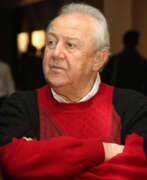

Zurab Konstantinovich Tsereteli (Russian: Зураб Константинович Церетели), a Georgian-Russian artist renowned for his monumental sculptures, has left an indelible mark on the landscape of modern art. Born in Tbilisi in 1934, Tsereteli expanded his artistic vision beyond painting after moving to Paris in the 1960s, where he was influenced by luminaries such as Picasso and Chagall. His work is characterized by a blend of dramatic, unconventional styles that have spurred debate but undeniably contributed to the cultural fabric of cities around the world.
Tsereteli's artworks, ranging from sculptures to paintings, are displayed globally, embodying his ethos that "art unites people." Noteworthy projects include the Peter the Great statue in Moscow, the Birth of the New Man in Seville, Spain, and the Tear of Grief in Bayonne, New Jersey, a poignant memorial to the victims of the 9/11 attacks. His commitment to fostering international cultural exchanges is evident in his role as the President of the Russian Academy of Arts and a UNESCO Goodwill Ambassador.
Beyond his public commissions, Tsereteli's contributions to education and the arts are profound. He founded the Moscow Museum of Modern Art and the Museum of Modern Art in Tbilisi, promoting modern and contemporary art in Russia and Georgia. His dedication to the Russian Academy of Arts underscores his belief in the importance of nurturing artistic talent and preserving the heritage of the academic school of fine arts.
For collectors and experts in art and antiques, Tsereteli's oeuvre offers a unique investment in pieces that are not only visually striking but also rich with cultural significance. His work encapsulates the dynamic interplay between traditional and contemporary art forms, making each piece a testament to his lifelong dedication to artistic innovation and cross-cultural dialogue.
To stay updated on new exhibitions, sales, and auction events related to Zurab Konstantinovich Tsereteli, sign up for updates. This subscription is a gateway to the latest developments in the world of a towering figure in art, offering exclusive insights into his ongoing contributions to the global art scene.


Max Uhlig is a German painter. He won the Hans Theo Richter-Preis of the Sächsische Akademie der Künste in 1998.
In 1978, Max Uhlig presented his characteristic paintings for the first time in the Dresden Kupferstichkabinett.
"Black and white or in colour, lines in the expressive rhythm of their superimposition draw the image mode and the conciseness of an extensive, unmistakable work that is a discovery. Today Max Uhlig is one of the last representatives of the era of open-air painting in modern art that began 150 years ago, but his work elevates it to the height of our time." His late work received significant impulses from annual stays in Faucon (southern France) from 1991 to 2010.
Max Uhlig has been a member of the German Association of Artists since 1990 and a founding member of the Saxon Academy of the Arts. From 1995 to 2002, he was the professor for painting and graphics at the University of Fine Arts in Dresden.


Alexander Nikolayevich Volkov (Russian: Александр Николаевич Волков), an avant-garde Russian artist, has left a significant mark on the art world with his unique blend of Cubism and Eastern aesthetics. Born in 1886 in Fergana, Uzbekistan, Volkov was deeply influenced by the vibrant culture and landscapes of Central Asia, which is vividly reflected in his works. His approach combined geometric forms, rich color palettes, and themes from daily life in Turkestan, making his paintings a unique fusion of European avant-garde styles and Uzbek traditions.
Volkov's paintings are distinguished by their dynamic compositions, intricate use of color, and incorporation of traditional motifs, reminiscent of oriental carpets. This stylistic amalgamation is particularly evident in his celebrated works such as "Pomegranate Teahouse" and the "Caravan" series, where he achieved a dramatic interplay of forms and colors. Despite facing political challenges and periods of obscurity due to his avant-garde methods, Volkov's commitment to depicting the essence of Eastern life and his innovative use of geometry and color have solidified his legacy as a pioneer of contemporary art in Central Asia.
His notable contributions to art and education were eventually recognized when he was awarded the title of People's Artist of the Uzbek SSR in 1946. Volkov's influence extended beyond his lifetime, with his works being featured in major exhibitions and collections, including the State Tretyakov Gallery in Moscow and the State Museum of Oriental Art. His artistic legacy continues to inspire and captivate audiences worldwide, highlighting the cultural richness of Uzbekistan and the innovative spirit of early 20th-century avant-garde art.
For those interested in exploring the vibrant interplay of Eastern culture and avant-garde artistry, Alexander Nikolayevich Volkov's work offers a fascinating journey. Sign up for updates on new product sales and auction events related to Volkov's art and delve deeper into the legacy of this remarkable artist.
